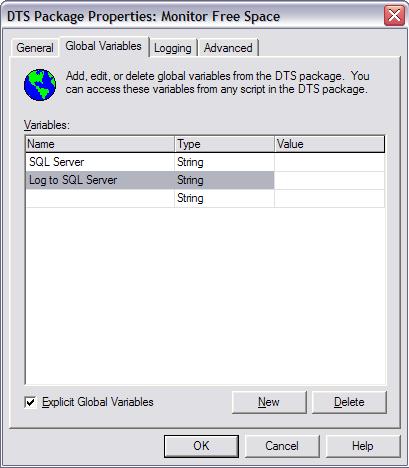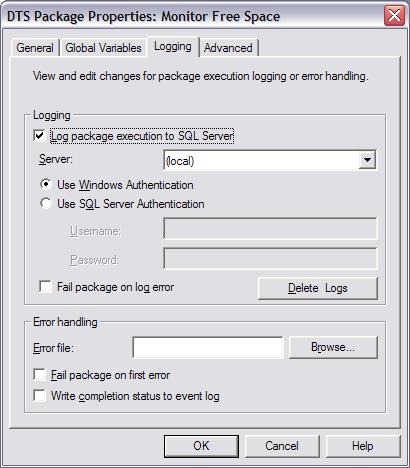Free Space Monitoring ToolBy Bill Wunder
One of the know problems with SQL Server 7 and SQL 2000 up to and including SP3 is that you can’t always depend on auto grow to allocate more space to data devices when necessary. I have described one such horror story where this happened to me in the previous article: The Database that Wouldn’t Grow.
I don’t know of anything in the provided SQL Client tool set that will tell me how much free space a database device has other than the Enterprise Manager (EM) task pad for a database. I wanted to find a better way to keep track of when a device was getting low on free space and I wanted to automate the process of being informed of the need to expand a database. In the back of my mind I even wanted to be able to expand a device before I hit the point of critical failure once I was sure the monitoring capabilities were solid. I built a Distributed Management Objects (DMO) based utility that will capture the values that EM uses, store them in a table, and send me an email when the available free space for any file drops below a threshold that I have defined. Once I'm comfortable that the utility is always accurate with it's emails I may look into adding the ability to auto-grow using DMO if that seems worthwhile. I'm actually hopeful that for the most part my databases maintain stable sizes and I won't need to extend enough files to justify the automation of growth within my utility.
I decided to use a DTS ActiveX task to loop through all the data devices in all database to extract the DMO info I needed and, using ADO and a stored procedure, insert that info to a table. Once I had all the data in a table I could easily query the table, again using that same ADO connection and a stored procedure that will send me and email if action is required, to determine if I had a device that needed to be expanded. I would also be building a history of the growth trends to aid in making more accurate decisions in the future. Later I can enhance the ActiveX script to use the DMO connection to actually expand a device when necessary.
Examine the lines from my ActiveX script to notice that the data collected is based upon the DMO DBFile object. You can find out everything you might want to know about the DBFile object by looking in SQL Server Books on Line in the DMO topic of the “Building SQL Server Applications” chapter (or just by typing in “DBFile” in the BOL keyword search).
Notice also that I’m collecting all the size properties of the DBFile object so I’ll want a table with columns to store all data I'm collecting to enable some historical trend analysis of file growth. I'll name this table SpaceUsedHistory.
create table dbo.SpaceUsedHistory ([Server] varchar(128) , [Database] varchar(128) , [FileGroup] varchar(128) , [FileName] varchar(128) , [File] int , [Path] varchar(128) , [IsPrimaryFile] bit , [Size] int , [SizeInKB] float , [SpaceAvailableInMB] int , [FileGrowth] int , [FileGrowthInKB] float , [FileGrowthType] int , [MaximumSize] int , [RecCreatedDt] datetime constraint dft_SpaceUsedHistory__RecCreatedDt default getdate() , [RecCreatedUser] varchar(128) constraint dft_SpaceUsedHistory__RecCreatedUser default suser_sname() , constraint pk_SpaceUsedHistory__RecCreatedDt__Server__Database__FileGroup__FileName primary key ([RecCreatedDt], [Server], [Database], [FileGroup], [FileName]))
The complete code for the tool can be found in two scripts referenced below. One script contains the T-SQL components of the tool: two stored procedures used and a script to create the SQL Agent Job. The other contains the ActiveX VBScript used in the DTS Package.
I’ll use the stored procedure SpaceUsedByFileGroupInsert to add the collected rows to my table. So that every implementation of the tool is quick and easy I'll always check for the existence of the table in this stored procedure. If the table isn't found the procedure will create it before it does the insert. And I'll use the stored procedure SpaceUsedByFileGroupLowFree to determine a critical space condition and notify me when it detects a device needs to grow up.
I built the DTS package to be completely portable and saved it as a Structured Storage File on a network share that all my SQL Servers can see. This way if I need to modify or want to enhance the package I need make the change in only one place and it will work everywhere. This also helps me make sure my DTS packages are somewhere where they get backed up regularly. I left logging enabled to the “(local)” SQL Server so where ever it is executed I will be able to look in msdb.dbo.sysdtspackageslog on that server to find the errors in the event of a failure.
Side note: Try a query like this to look at the failure messages that logging generates for your DTS packages. This will show them for that last several days, the most recent first. I use this query (with all the white space removed and the complete statement on a single line) as one of the Custom Shortcuts in my Query Analyzer. select char(10) + '###' , s.starttime , p.name + ' - ' + s.stepname , s.errordescription from msdb.dbo.sysdtssteplog s join msdb..sysdtspackagelog p on s.lineagefull=p.lineagefull where s.starttime > getdate() - 8 and s.stepexecresult <> 0 order by s.starttime desc
To create the package right click on the "Data Transformation Services" folder found by expanding the level just under any SQL Server. Select "New Package" from the context menu. Add an ActiveX Script Task by selecting the "ActiveX Script Task" icon in the Tasks section of the toolbar. Paste the admin dts - Free Space Monitoring Tool ActiveX Script Task script into the code box of the task and enter "Check free space in all files" in the "description" input box at the top of the ActiveX Script Task dialog. Click OK. The script is now part of the package, but we still need to add a couple of Global Variables to the package and enable logging before we actually save the the package. Right click in the package background and select "Package Properties" from the context menu. Navigate to the Global Variables tab and enter the global variable "SQL Server" and "Log to SQL Server" as shown in figure 1
figure 1
Now navigate to the Logging tab and set logging to always go to the "(local)" SQL Server as shown in figure 2.
figure 2
Save the package to a share that all your SQL Servers can read using the package name "Monitor Free Space" and the file Name "Monitor Free Space.dts".
Feel free to change those names as you desire, but keep in mind that the job script I have provided expects to find the package with this name in the file with this name. Even though I wrote the package to be able to log to a different server than it collects the DMO info from, I implemented it to always log to the local table by creating a SQL Agent Job that uses Agent Tokens rather than hard coded server names so I can load that exact same job on any server and it will do the correct actions provided I make sure the two stored procedures and the table are in place on that server. Here’s what the Job Step command needs to look like when using tokens:
(Note that everything needs to be on one line in you job, the SQLAgent CMDEXEC shell doesn’t like carriage returns!)
This is a good time to point out that the script also expects to you add the correct path to the location where you have saved this file to the job step before you create the job.
You'll find the SQL Agent Job Script at the bottom of the sql script . Note that I use a second job step for failure notification rather than depending on the SQL Agent notification feature and SQL Mail. I hope to describe this in more detail in a future article.
Whether to write the SpaceUsedHistory data to a central server or to the local server or to save it at all is a subjective preference. Some people like to have a central spot, along the lines of the Multi Server Administration capabilities of Enterprise Manager. I prefer to keep historical tables and I like to keep the historical data with the server it was collected from rather than logging to a “master” server and then having to weed through a larger pool of data to get my answers. Another advantage I see to using the local server is that when ever the server I’m collecting the data from is available to collect data I know that the server where I’m storing my history is available to receive the data. No issues of network connectivity or the master server being down to contend with. You decide what's right for you. If you want a central store, all you need to do is edit the job so that "Log to SQL Server" Global Variable is hard coded to the location of your central store rather than tokenized to always use the local server.
With that you have a tool that will monitor and track the space used and free space available for every file in every data file group in every database on any SQL Server. We also have the capability through the virtual table master.dbo.sysperfinfo to monitor, track, and manage the space used and available in log files. In a future article I’ll try to say more about that aspect of managing space.
Bill
|

